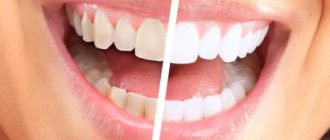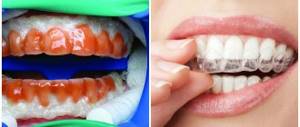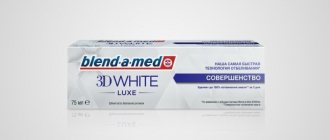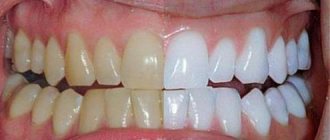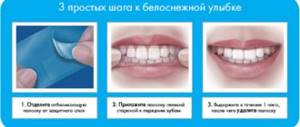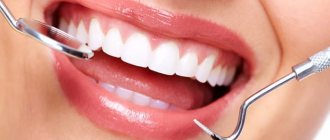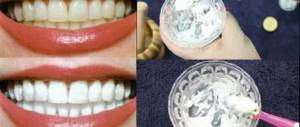It will not be a secret that most people now have fillings, crowns, or dentures. This is caused by modern lifestyle, poor diet, and poor quality care. And because of this, the question of whether it is possible to whiten teeth with fillings is becoming very popular. Of course, there is not and cannot be a definite answer, because a lot depends on a variety of factors. In this article we will try to consider all situations, possible solutions, and, of course, give you useful tips!
But it is important to understand that a lot depends on your circumstances - so it’s better to come to our specialist at SDent at the trade union, he will tell you whether it is possible to whiten a tooth with a filling, name the exact price and answer all your questions. We will consider the most typical situations that occur very often in medical practice.
Is it possible to whiten teeth with fillings?
As a rule, when teeth are whitened with filling material, the tooth filling remains the same color, and the tooth enamel becomes several shades whiter. In cases where the tooth filling occupies most of the surface, it is not recommended to whiten them. This recommendation especially applies to the front teeth located in the smile zone, this is due to the fact that the tooth takes on a “spotty color” after bleaching. If the dental filling is on the front teeth, the internal restoration may be visible through the enamel. In such situations, the dental veneering procedure will help give a lighter shade to the tooth.
If the tooth filling is located on the chewing teeth (distant teeth), and the size of the filling is small, then there are no aesthetic contraindications, and whitening is recommended.
Teeth whitening technology
As you may have noticed, in each unique case, it is necessary to look for a unique approach. But we can make a generalization about the technological process of professional teeth whitening! Firstly, professional cleaning is necessary to get rid of caries and other diseases. Secondly, it is necessary to decide on the location of the seals and select the necessary tactics of action. Thirdly - whiten the enamel! And, finally, insert new, lighter fillings, or veneers.
We think that now you will not have any questions about whether it is possible to whiten teeth with a filling. Modern technologies allow every person to have a snow-white smile, regardless of the specific situation and conditions. Smile so that people around you admire your smile. In fact, you will also be delighted with your snow-white teeth if you contact our clinic.
Teeth whitening with fillings on the front teeth is a way out of the situation
Dental fillings, unfortunately, do not whiten, however, if you plan to whiten the filled front teeth, first of all you need to carry out the teeth whitening procedure itself, and then wait a period of about two weeks, after which, at a second visit to the dentist, the teeth with fillings should be filled new to match your new, whiter color.
After whitening, a period of approximately two weeks is required before replacing fillings. This is because it takes a period for the color of your healthy teeth to stabilize after whitening. If caries is present, treatment and filling of the tooth must be carried out before safe whitening. Over time, the color of the tooth filling will change and will not match the color of the whitened teeth; in this case, the patient is recommended to renew the tooth filling by waiting the period of time recommended by the dentist.
Is it possible to whiten metal-ceramic crowns?
Unfortunately, it is impossible to achieve perfect whitening of fillings and metal-ceramic crowns. So, for example, modern dental ceramics is a fairly dense and hard material, so the brightening compounds used today have practically no effect on it.
The photo shows a metal-ceramic crown
But if the restored areas and prosthetic structures are located in the posterior parts of the jaw, the front teeth can be whitened. Then the difference in shades will not be noticeable. Otherwise, it will not be possible to achieve uniform whitening and an aesthetically pleasing smile. To do this, you will have to look for other solutions to the problem.
Dental procedures
Modern dentistry offers a wide range of procedures aimed at making teeth whiter. Of course, they have a high cost, but they provide a reliable effect, almost completely eliminating negative consequences. Among them:
- Chemical bleaching (can be done at home). An impression is taken of the teeth, on the basis of which special mouth guards are made. Cheaper standard options can be purchased at pharmacies. They are filled with whitening gel, the main component of which is hydrogen peroxide. The mouthguards must be worn for 2 weeks for 2 hours during the day or put on them at night. Although the cheapest of all methods, it is not suitable for people with sensitive teeth.
- Professional cleaning. The advantages of the procedure are speed, safety and simultaneous prevention of dental diseases.
- Ultrasonic whitening (more details in the article: how is ultrasonic whitening carried out?). Removes plaque and stones without harming the enamel.
- Photobleaching. A gel similar to what is placed in mouth guards is applied to the teeth, after which they are exposed to ultraviolet light. Afterwards, fluoride treatment of the teeth is required to eliminate their sensitivity. This technique does not always give the desired result.
- Laser whitening. The most effective and at the same time expensive method. Lightens enamel up to 12 tones.
The only alternative
If you have metal-ceramic structures that do not suit you in color, the only right solution is to replace them. Metal ceramics have a certain service life. Over time, the ceramic surface can wear off and chip, which affects aesthetics.
At our dentistry in Moscow, orthopedists install highly aesthetic dentures that will not only create a snow-white smile, but also reliably protect teeth from external influences.
Ceramic crowns on a zirconium dioxide frame are the best prosthetic option in all respects. These designs combine the strength of zirconium dioxide and the high aesthetics of a ceramic coating. A perfect, precise fit to the gum, the high light transmittance of these crowns creates an unrivaled smile. The cost of such prosthetics is high, but the result justifies the cost.
During your consultation, orthopedic dentists at our clinic will tell you in detail about all the features of these structures, give you an idea of the cost and the number of visits needed to create a snow-white smile.
Principles of caring for metal-ceramic crowns
To prevent darkening of fillings and crowns, it is important to provide competent and systematic oral care. As mentioned above, basic hygiene rules include regular brushing of teeth twice in the morning and evening, rinsing after each meal, as well as visiting the dentist for prevention and cleaning of dental plaque at least once every six months.
If you have a bridge in your mouth with metal-ceramic crowns, it is important not to forget to clean the rinsing channel located between the gum and the structure. An irrigator is ideal for these purposes. Experts in the field of prosthetics also provide the following recommendations regarding the care of metal ceramics:
- try to avoid temperature changes in food and drinks, due to which the porosity of the material increases and it turns yellow,
- If possible, avoid coffee and strong black tea, since these drinks quickly lead to staining,
- You should not gnaw hard foods with your teeth or crack the shells of nuts and seeds.
An irrigator is an additional device for maintaining oral hygiene.
To keep your teeth healthy and your smile snow-white, you need to pay enough attention to caring for and maintaining hygiene. Modern fillings are made from high-quality materials that cannot be stained for a long time. The same can be said about modern dental ceramics, which are distinguished by their durability, high aesthetics and color fastness. Therefore, with proper care, the material will not darken and will retain its aesthetic properties throughout its entire service life.
1According to data at the office. manufacturer's website: dentalpaint.ru.
What to do if ceramic dentures are darkened by plaque
How to whiten ceramic teeth that have become darker due to bacterial plaque? It has already been noted that it is impossible to bleach ceramics. But you can make it lighter with the help of dental procedures - for example, by removing tartar and plaque using professional oral hygiene. It is carried out by dentists - a therapist and a hygienist. The stone is very carefully removed from teeth and dentures using an ultrasonic scaler and hand instruments - it is important that the ultrasonic waves do not disturb the fixation of the orthopedic structure.
And plaque is removed with gentle air-abrasive Air-Flow (“Air-Flow”). Next, doctors use a professional paste for cleaning, and at the end of the procedure they perform polishing. An additional bonus of professional hygiene is that your own enamel becomes 1-2 tones lighter.
Common Myths
Below are the most popular misconceptions and myths regarding plaque on teeth:
- The culprit behind the appearance of yellow plaque is sinusitis. Despite the fact that the maxillary sinuses and teeth are located next to each other, this does not affect the shade of the latter in any way.
- Hot food violates the integrity of the enamel. During heat treatment, harmful bacteria are destroyed in products, which cannot be said about raw food.
- Herbal remedies and agents that have an antiseptic effect contribute to tooth staining. Products such as chamomile or sage decoction and chlorhexidine solution fight pathogenic microflora without causing staining.
- Apples cause yellowing of the enamel due to their high iron content. Solid foods, on the other hand, promote natural whitening of teeth, keeping them healthy. For a white smile, you should eat one apple a day.
- Teeth become yellow from lipstick after a kiss. Saliva, which is more actively secreted during a kiss, performs protective functions, preventing the proliferation of bacteria. The lipstick itself is easily washed off, leaving no marks on the surface of the teeth.
rated 4.50 out of 5) Loading...
Recommendations after teeth whitening
Even gentle procedures have an impact on the surface layer of dental tissue. For several days, the enamel will become more susceptible to staining and remain highly sensitive. For this reason, you need to stop smoking and consuming “coloring” foods, for example, beets, red wine, tea. Food should be at a comfortable temperature. Hot or cold food can cause discomfort and even pain.
You need to brush your teeth with a brush with soft bristles and preventive pastes. After each meal, it is recommended to rinse your mouth with clean water or mouthwash. Additionally, use an irrigator, floss, and dental brushes.
Possible consequences of the procedure and contraindications
A consultation with a dentist is necessary, regardless of whether you whiten your teeth yourself, use special or “improvised” products, or use professional services.
Bleaching, especially if done improperly at home, can cause:
- damage to enamel and development of caries;
- increasing the sensitivity of enamel and the reaction of teeth to temperature and sweets;
- imbalance of minerals in tooth enamel;
- chemical burns.
In some cases, enamel lightening is not recommended at all (both professional and amateur). The main contraindications include:
- pregnancy;
- wearing braces (due to uneven lightening);
- allergy to components of bleaching compositions;
- the presence of carious teeth in the oral cavity (caries must first be treated);
- increased sensitivity of tooth enamel;
- damage to the oral mucosa (infectious, inflammatory, traumatic).
Do not lighten the teeth of children under 18 years of age. It is not advisable to carry out independent bleaching if the filling area is large, or if there is a cavity or an open channel. If you have had a tooth removed, lightening is not recommended until the tissue is completely restored, that is, at least 6 months from the date of removal.
The whitening procedure involves not only exposing the tooth to ultrasound and a special lamp, but also chemicals (as in Zoom3 technology). Changing the color of enamel in this way is relatively safe, but has some restrictions on its use. Absolute and temporary contraindications to the whitening procedure include:
- diseases of the oral cavity (for example, caries, pulpitis or periodontitis);
- pregnancy and lactation;
- wearing braces;
- allergic reaction (individual intolerance) to substances used in bleaching;
- damage to the enamel in the neck area on the outside of the tooth;
- malignant neoplasms;
- undergoing a course of chemotherapy.
How to protect yourself from problems with dentures
In order for new teeth to maintain an attractive appearance for a long time and not cause other problems, you must initially carefully approach the choice of a clinic and an orthopedic dentist. It is advisable if dentistry has its own dental laboratory, where modern and high-quality ceramic materials are used. For example, ceramics, glass ceramics, fluorapatite, zirconium dioxide from Ivoclar Vivadent (IPS E.Max), Prettau, Kuraray Noritake, VITA Zahnfabrik. And the specialists were trained by material manufacturers, i.e. know how to handle them correctly.
Another important step is that before prosthetics, professional cleaning with ultrasound and Air-Flo is required, and sometimes professional whitening. After all, if your enamel is covered with plaque, then it looks darker than its natural shade - that is, the prosthesis will be made the same color. And then the patient wants to whiten his teeth or even just have his teeth professionally cleaned - as a result, the crown or veneer will turn out to be darker than the rest of the row. Therefore, do not neglect professional cleaning BEFORE prosthetics - a good dentist himself will offer to undergo it, because... understands all the risks.
Is it possible to whiten teeth at home?
To maintain the natural whiteness of your teeth, it is important to brush them twice a day with a properly selected brush and toothpaste, rinse your mouth after every meal, use floss and antibacterial rinses, give up cigarettes and coffee, and undergo a professional procedure. hygiene every six months.
But if you naturally have a slightly yellowish or grayish tint to your enamel, even following all of the above measures will not be able to ensure an impeccably white smile. To do this you will have to resort to bleaching. This can be done at home in several ways:
- pencil - brightening gel is produced in a special tube, at the end of which there is usually a soft brush, brush or sponge for convenient application of the composition to the enamel surface. You must use the whitening pencil strictly according to the instructions. Typically, the gel is applied twice in the morning and evening for 2 weeks.
- strips and aligners - the gel can be immediately applied to the strips, which should be glued to the outside of the teeth for a certain time. Other systems include special mouth guards. Their inner surface must be independently coated with a lightening composition and then put on the dentition,
- abrasive pastes - they usually contain coarse abrasive particles, due to which the whitening effect is achieved. However, you cannot use them on an ongoing basis, otherwise you can damage the enamel, which will lead to its weakening and increased sensitivity - the development of hyperesthesia.
When whitening at home, a tray with a special gel is often used.
Before trying any of the methods described above, you should definitely consult a doctor. The specialist will conduct a visual inspection and determine the current condition of the enamel, and give his recommendations on choosing the appropriate system. If the enamel is weakened, thinned or too sensitive, the use of whitening strips and abrasive pastes is strictly contraindicated.
What methods of whitening are there in dentistry?
Before we figure out how to whiten ceramic[1] teeth, let’s first look at what whitening methods exist. So, the methods by which you can whiten living enamel are essentially of two types:
- abrasive (mechanical): small and hard particles of the whitening agent scrape off plaque and pigmentation from the surface of the teeth. The clinic uses the Air-Flow hardware method for this, when a mixture of air, drops of water and fine powder is applied to the patient’s teeth under pressure. At home, pastes with a high abrasiveness index (RDA more than 100) are used. It is impossible to whiten stubborn stains, just as it is impossible to make teeth lighter than their natural shade,
- chemical: it whitens the enamel from the outside and a little from the inside - it depends on how deeply the bleaching agent penetrates. The whitening gel contains hydrogen peroxide and/or carbamide peroxide. Using this technique, you can lighten your teeth by 8-12 shades in a clinic and by 2-3 shades at home.
The chemical technique, in turn, can be supplemented by activating the whitening gel with a special lamp - LED, ultraviolet, laser. These are the most effective methods, because... they provide 10-12 shades of whitening.
